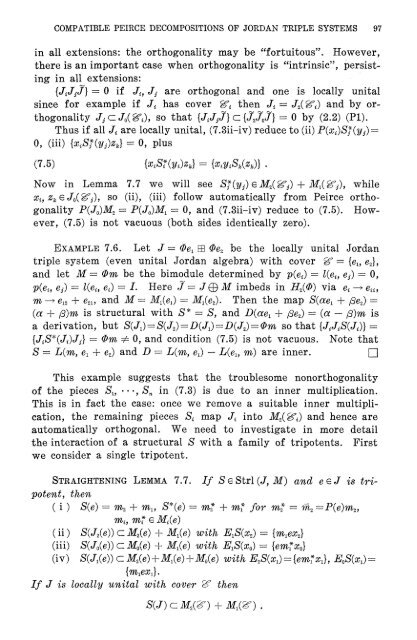Compatible Peirce decompositions of Jordan triple systems - MSP
Compatible Peirce decompositions of Jordan triple systems - MSP
Compatible Peirce decompositions of Jordan triple systems - MSP
Create successful ePaper yourself
Turn your PDF publications into a flip-book with our unique Google optimized e-Paper software.
COMPATIBLE PEIRCE DECOMPOSITIONS OF JORDAN TRIPLE SYSTEMS 97<br />
in all extensions: the orthogonality may be "fortuitous". However,<br />
there is an important case when orthogonality is "intrinsic", persisting<br />
in all extensions:<br />
{JiJjJ} = 0 if Jί9 Jά are orthogonal and one is locally unital<br />
since for example if Jt has cover g^ then J; = J2(&i) and by orthogonality<br />
JjdJά&i), so that {JtJjJ} c {J2J0J} = 0 by (2.2) (PI).<br />
Thus if all Jt are locally unital, (7.3ii-iv) reduce to (ii) P(xi)S*(yί) =<br />
0, (iii). {xSt(Vό)zk} = 0, plus<br />
(7.5) {XiSΐίvM = {x iyiS k(z k)} .<br />
Now in Lemma 7.7 we will see Sf(y/) eM 2{^ 5) + M^ 5), while<br />
x i9 ^eJoί^ ), so (ii), (iii) follow automatically from <strong>Peirce</strong> orthogonality<br />
P(J 0)M 2 = P{J 0)M 1 = 0, and (7.3ii-iv) reduce to (7.5). However,<br />
(7.5) is not vacuous (both sides identically zero).<br />
EXAMPLE 7.6. Let J = Φe1 ffl Φe2 be the locally unital <strong>Jordan</strong><br />
<strong>triple</strong> system (even unital <strong>Jordan</strong> algebra) with cover g 7<br />
= {el9 β2}, and let M = Φm be the bimodule determined by p(et) = l(eif eά) = 0,<br />
Vifiu e<br />
o) " Kfiit e<br />
i) — I- Here J = J0 Λf imbeds in iί2(Φ) via ^ —> e«,<br />
m-^e 12<br />
+ e 21, and M = MΊ(ej) — Mi(β 2). Then the map S(ae ι + /3e 2) =<br />
(α + β)m is structural with £* = S, and jD(αe! + /3e 2) = (α — /5)m is<br />
a derivation, but S(J 1) = S(J 2) = D(J 1)=D(J 2) = Φm so that {J^S^)} =<br />
{JiS*(J t)J d} = Φm Φ 0, and condition (7.5) is not vacuous. Note that<br />
S = L(m, e x + e 2) and JD = L(m, e t) — L(e l9 m) are inner. •<br />
This example suggests that the troublesome nonorthogonality<br />
<strong>of</strong> the pieces Su -—,Sn in (7.3) is due to an inner multiplication.<br />
This is in fact the case: once we remove a suitable inner multiplication,<br />
the remaining pieces St map Jt into ikf2 (i^) and hence are<br />
automatically orthogonal. We need to investigate in more detail<br />
the interaction <strong>of</strong> a structural S with a family <strong>of</strong> tripotents.<br />
we consider a single tripotent.<br />
First<br />
STRAIGHTENING LEMMA 7.7. If S e Strl (J, M) and eeJ is tripotent,<br />
then<br />
( i ) S(e) = m 2 + m 19 S*(e) = m? + m* for m 2 = m 2 =P(e)m 2 ,<br />
m i9 mf e M t (e)<br />
(ii) S(J 2 (e)) c M 2 (e) + M L (e) with Eβ(x 2 ) = {m.ex,}<br />
(iii) S(J 0 (e)) c M 0 (e) + MM with Eβfa) - {emfx 0 }<br />
(iv) SiJM) c MM + MM + Moie) with E 2 S(x 1 ) = {em?x 1 }, E 0 S(x ί ) =<br />
// J is locally unital with cover & then<br />
S(J)czM 2(t?)













